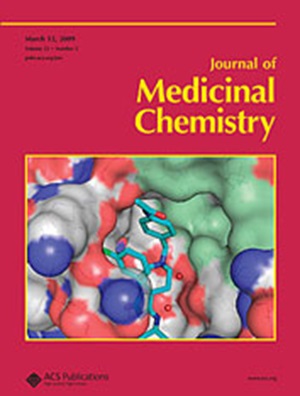Development of Diphenyl-1,2,4-Oxadiazole Analogues as Allosteric Modulators of the RXFP3 Receptor: Evaluation of Importance of the N-Substituted-2-Pyrrolidone Moiety in RLX-33
IF 6.8
1区 医学
Q1 CHEMISTRY, MEDICINAL
引用次数: 0
Abstract
Relaxin-3/RXFP3 antagonism is a novel strategy for drug development to treat alcohol use disorder (AUD). We recently discovered the first-in-class RXFP3 negative allosteric modulators (NAMs), represented by RLX-33, which significantly reduced alcohol consumption in rats. In this study, we report the design and synthesis of a series of diphenyl-1,2,4-oxadiazole analogues derived from RLX-33. Structure–activity relationship studies of sites A and B of RLX-33 revealed that the aromatic ring at site A is not required for RXFP3 allosteric modulation and the pyrrolidone linker at site B could be replaced with a cyclic or linear alkylamine. Compound (R,R)-3 has improved potency and ADME properties (e.g., solubility and metabolic stability) compared to RLX-33, while maintaining high receptor subtype selectivity over RXFP1 and RXFP4. Importantly, (R,R)-3 significantly attenuated alcohol self-administration without affecting sucrose self-administration and general locomotor activity in rats, demonstrating the potential of RXFP3 NAMs as promising drug candidates for AUD.

求助全文
约1分钟内获得全文
求助全文
来源期刊

Journal of Medicinal Chemistry
医学-医药化学
CiteScore
4.00
自引率
11.00%
发文量
804
审稿时长
1.9 months
期刊介绍:
The Journal of Medicinal Chemistry is a prestigious biweekly peer-reviewed publication that focuses on the multifaceted field of medicinal chemistry. Since its inception in 1959 as the Journal of Medicinal and Pharmaceutical Chemistry, it has evolved to become a cornerstone in the dissemination of research findings related to the design, synthesis, and development of therapeutic agents.
The Journal of Medicinal Chemistry is recognized for its significant impact in the scientific community, as evidenced by its 2022 impact factor of 7.3. This metric reflects the journal's influence and the importance of its content in shaping the future of drug discovery and development. The journal serves as a vital resource for chemists, pharmacologists, and other researchers interested in the molecular mechanisms of drug action and the optimization of therapeutic compounds.
 求助内容:
求助内容: 应助结果提醒方式:
应助结果提醒方式:


